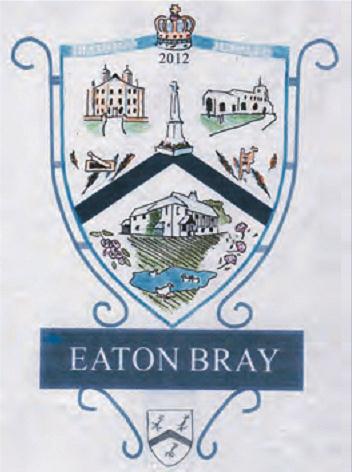The Eaton Bray Village Sign
Posted on August 20, 2012
 Designed to commemorate the Queens Diamond Jubilee 2012, it is a shield based on the Bray family's Coat of Arms and depicts scenes from Eaton Brays past. It is topped off with a crown as a mark of respect for Her Majesty Queen Elizabeth the Second in her Diamond Jubilee year.
Designed to commemorate the Queens Diamond Jubilee 2012, it is a shield based on the Bray family's Coat of Arms and depicts scenes from Eaton Brays past. It is topped off with a crown as a mark of respect for Her Majesty Queen Elizabeth the Second in her Diamond Jubilee year.
In the top left hand side is an image of the last Manor House in Eaton Park which was pulled down circa 1790. Before this, there had previously been a Manor House of Sir Reginald Bray that had been built on the site of the castle of William Cantelupe which stood here in 1221 surrounded by the moats.
Top right is St. Marys Parish Church, a 13th century example of Parish Church craftsmanship with magnificent arcades built with local Totternhoe stone (clunch). A 13th century font survives as does the famous Thomas-De-Leighton door hinge. A short walk back to the church you will find a brief history and guide book on sale and your chance to bide-a-while in this historic place of worship.
Centre is the War Memorial with the names of the local lads who gave their all for us in the two World Wars. Dedicated in July 1923 by S. Howard Whitbread.
Lower left, shows a device for breaking down Hemp (Flax) for the making of rope. It was used as a symbol by the Bray family known as "the Hemp Bray" or Brake.
Lower right. A device called a Plait Mill, it was used to flatten the plait much like a mangle. Our village was once famous for its straw plait, indeed, I doubt it could have survived in the 18th and 19th centuries without it. Straw was plaited into lengths of 20 yards – or a "score" as it was known, and sold to the hat manufacturers in Luton.
The Chevron shown here comes from the Coat of Arms of the Bray Family (seen below on the post).
Lower centre. Moat Farm in the High Street. Once the home of the Henley's, they were one of the larger duck breeders in the village. It was said that you could smell the ducks as you came down Lancot Hill. The Henley's also manufactured bricks and tiles form the area now covered by bungalows in Church Lane. The clay dug in these pits contains no iron and as a result the bricks produced were a yellow colour. There are plenty about in the village, see if you can spot them.
The Bray Coat of Arms.
The shield is divided by a chevron and depicts three Eagles feet showing their claws. These were said to be "armed", that is to say the Brays were fighting men or Knights. We know that Reginald Bray was fighting at Bosworth Field as it was reputed to be he who found the fallen crown on a thorn bush and handed it to Lord Stanley who, in turn, placed it upon the head of Henry Tudor, Earl of Richmond proclaiming him Henry V11 in 1485. Five weeks later Reginald was knighted by the king, and granted the manor of Eyton for his services, hence the modern name Eaton Bray.
Lower right. Carnations represent W.E.Wallace and Son Ltd. one time Eaton Bray's largest employers. Starting up in Eaton Bray in 1886, they went from strength to strength producing thousands of blooms a day right up to the mid 1970's. The range of colours was wide and included numerous varieties that were grown only by this company. Some of the names live on like Wivelsfield, Northcliffe. Coral and Saffron Rise as road names on the Wallace Drive Estate.
Lower left. Prunes, this unique variety of plums grow only on the Vale of Aylesbury from Hockliffe in the north to Western Turville. All the villages in between grew the crop and on a good year could fetch £80 per ton. A small orchard could produce enough fruit in a season that, when sold, would pay the rent on a cottage for a year.
Source: Focus, August/September 2012
Reader Comments
October 26, 2012
,Harry Hatter says:I'd prefer to see the Coffee Tavern and the old school depicted along with the church, the idea being you then have local democracy, faith and education represented in village life with all the little industry bits as they are, except perhaps not the ducks, ducks are associated with aylesbury.